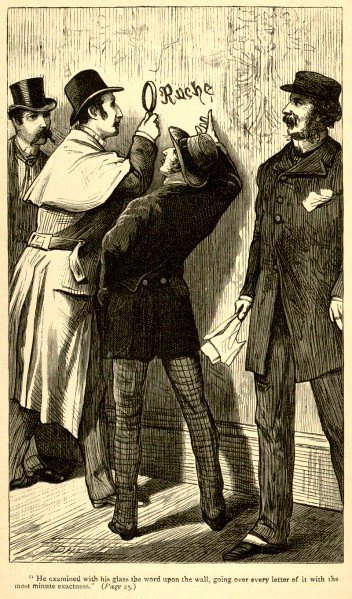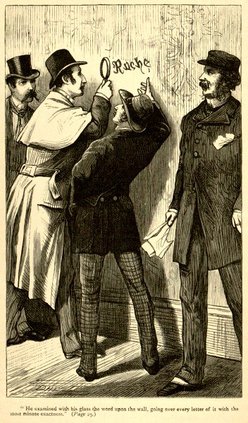Each week we’ll take a step back into the history of Great Bend through the eyes of reporters past. We’ll reacquaint you with what went into creating the Great Bend of today, and do our best to update you on what “the rest of the story” turned out to be.
One-hundred-thirty years ago today, Americans were introduced to the British detective Sherlock Holmes with the publication of the first US edition of Sherlock Holmes first novel length story, “A Study in Scarlet: by Arhur Conan Doyle. It was published in England three years prior, after first appearing in an obscure magazine called Beeton’s Christmas Almanac under the title “A Tangled Skein.” In 1888, it was published in book form, with illustrations drawn by the author’s father. According to the Wikipedia page for the story, “a second edition appeared the following year and was illustrated by George Hutchinson; a year later in 1890, J. B. Lippincott & Co. released the first American version. Numerous further editions, translations and dramatisations have appeared since.”
A Study in Scarlet is the first time a detective is described as using a magnifying glass in a novel.
In the 1890’s magazines and newspapers regularly featured short stories, serial novels, poetry, and illustrations were hand drawn, as printers had yet to perfect inclusion of photos. International and national news was provided along with state and local news. Specialization of content wasn’t a thing back then. And news traveled slowly, so when looking at historical calendars of today, there is little that corresponded in real time back then. When we looked back at the Barton County Democrat from Feb. 27, 1890 and March 6, 1890, we weren’t surprised to find no mention of a Sherlock Holmes book. Likely, it would be weeks, months, possibly even a year or more before there would be any writings about or by Conan Doyle. Eventually, Sherlock Holmes short stories and serials were offered, and even a brief comic strip or two in later years.


Potluck
Today, we treat our readers to a pot-luck of 1890s reports and anecdotes from the Barton County Democrat. It was a weekly paper out of Great Bend, and competed directly with the Great Bend Register, a Republican paper, which was also a weekly. These reports offer clues to what was on the minds of Barton County readers when the county was still new.
In 1880, Kasnas passed a constitutional amendment prohibiting the manufacture and sale of intoxicating liquors in the state, which took effect in January 1881. But, enforcement was lax, and many counties turned a blind eye. Establishments were called “joints” and they willingly paid the $100 monthly fine in order to stay open. By 1890, according to the Kansas State Historical Society, the temperance movement faltered, though it never lost support. The Democrat was filled with references and reports:
“Great Bend papers report farmers sowing oats. As all of the joints there are still running, it is probable it may be wild oats.” — Wichita News-Beacon
“The question now arises “What will the harvest be?”
“The Great Bend citizen who got a jog of whisky, took it home and put it down cellar, and then found, the next time he went down to see that the potatoes had not frozen, that his wife had turned the jug upside down and forgot to put the cork in, is now in favor of resubmission. Some women are entirely too thoughtless.”
“At a prohibition meeting held in Topeka on Feb. 26, Hon. Samuel Dickie, of Michigan, severely rebuked the county attorneys of kansas who, while pretending to enforce the prohibitory law, accepted hush money and stood in with the jointists. He concluded by acknowledging that as an abstract proposition prohibition had been a failure in every state where it had been tried because officials elected by republican votes had not enforced it.”
Prohibition was only one concern in Barton County. Tariffs were working against farmers in 1890.
“He sat in the door at noonday, lonely and glum and sad; brooding over the price of corn and figuring how much he had. He had worked from early springtime, early and late, and hard, and now he was counting his last assets and figuring out his reward. He figured it took two acres to buy his three boys new boots, and ten acres more on top of that to fit them out with new suits. To Buy his wife a protected dress it took 100 bushels more, while five acres went in a solid lump for carpet on the floor. His taxes and his grocery bill absorbed his crop of oats, while the interest on his farm mortgage took all his fattened shoats. The shingles on his cow shed, and the lumber for his barn, had eaten up his beef steers and the balance of his corn. So he sat in his door at noonday, lonely and glum and sore, as he figured up his wealth a little less than it was the year before. “By gum, they say I’m protected, but I know there is something wrong; I’ve been deceived and gulled and hoodwinked by this protective song. They told of rebellious traitors and held up the bloody rag, and I followed along like a pumpkin, and now I’m holding the bag. But from this time on I’ll investigate and get to the bottom of facts, and I’ll be $4, to begin with, that the tariff is a tax.”
“A few days since a farmer came to town with a very small bunch of chickens under his arm and went home with $4.25 in cash in his pockets. The biggest kind of a load of corn at 14 cents a bushel would amount to less than $4.25. One dressed chicken will sell for almost as much as three bushels of corn.”
“Let’s see, a bushel of corn makes four gallons of liquor, the retail price of which is sixteen dollars. This sum is subdivided as follows: the farmer who raises the corn, 25 cents; the government, $3.60; the distiller, $4; freight, $1; the saloon keeper, $7.15; the consumer — snakes.” — Osage County Chronicle.
Finally, here’s a report on a scam, or in 1890-speak, a scheme, which might have prompted Sherlock Holmes himself to raise his magnifying glass.
“A sharper with a new scheme is traveling through some of the neighboring states, and may also strike this section. His method of operating is as follows: He has an improved plow share, which he loans to some influential farmer with the provision that if it proves satisfactory he will recommend it to his neighbors, and if, at the end of the season, he does not wish to keep it he is to return it to an address which is given him. If the unsuspecting farmer agrees to do this the sharper will write an article of agreement. This article is written with a peculiarly constructed fountain pen, here being two compartments in the holder which contains two kinds of ink one of which will fade away in a short time after being written, while the other will remain. With the former he writes the article and changing the ben hands it to the farmer, who signs his name with the latter kind. The result is that the words of the article soon face and the sharper has a piece of white paper with the farmer’s name theron, and can make it into a note of any denomination at his leisure.” — Newton Journal





